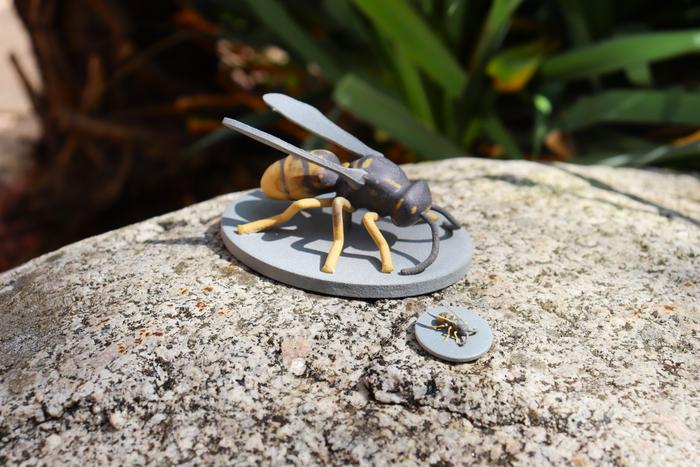
In a groundbreaking exploration into the mechanics of evolutionary biology, a team of researchers from the University of Nottingham has harnessed the power of cutting-edge 3D printing technology to unravel the mysteries of Batesian mimicry—where harmless species evolve to resemble harmful ones to avoid predation. By creating life-size, intricately detailed 3D-printed insect models, these scientists have pioneered a tangible approach to testing how predators respond to varying degrees of mimic accuracy, a question that has enraptured biologists for decades.
Batesian mimicry, named after the 19th-century naturalist Henry Walter Bates, is a classic example of how natural selection can drive complex interspecies interactions. However, despite the general understanding of this phenomenon, there remains uncertainty about what precisely limits the evolutionary refinement of mimics. Why do some hoverflies bear an uncanny resemblance to wasps, while others fall short of this deceptive mark? The Nottingham team’s innovative methodology offers unprecedented insight by enabling exact manipulations of insect morphology and coloration, thus isolating which traits most strongly influence predator behavior.
The researchers began by obtaining precise 3D scans of real wasps and their hoverfly mimics, establishing accurate blueprints from which to create a continuum of morphologically intermediate variations. Employing additive manufacturing—commonly known as 3D printing—they produced physical models that incorporated slight gradations in shape, size, and color patterning. This approach diverges from traditional observational studies by allowing controlled, repeatable experimentation on predator responses to nuanced mimicry imperfections, which is impossible with live insects due to biological variability and ethical concerns.
.adsslot_uUak1t4ds2{width:728px !important;height:90px !important;}
@media(max-width:1199px){ .adsslot_uUak1t4ds2{width:468px !important;height:60px !important;}
}
@media(max-width:767px){ .adsslot_uUak1t4ds2{width:320px !important;height:50px !important;}
}
ADVERTISEMENT
One of the study’s core investigative aims was to determine the ‘adaptive landscape’ of mimicry—essentially, mapping how changes in morphological traits correspond to survival advantages or disadvantages mediated through predator perception. By independently altering traits such as wing shape, body coloration, and pattern arrangement, the team could dissect the relative importance of each feature in deceiving natural predators, primarily birds and spiders. This allowed them to simulate “what-if” evolutionary scenarios with a level of precision previously unattainable in ecological studies.
Results revealed a striking finding: coloration emerged as the most critical factor in successful mimicry, underscoring its role as a fundamental visual cue for predator avoidance learning. While subtle shape alterations had less consistent effects, size was notably influential in certain contexts, potentially affecting the perceived threat level of the mimic. Moreover, the study confirmed that different predators exercise varying degrees of selectivity; birds, with acute color vision, demanded a higher fidelity of mimicry, whereas spiders, relying less on color, appeared more tolerant of inaccuracies.
These discoveries illuminate why evolutionary trajectories diverge, preventing some species from attaining perfect mimicry. The tolerances of different predator species create a multi-dimensional selection pressure landscape that shapes the diversity and complexity of mimic phenotypes observed in nature. This nuanced interplay also explains the persistence of “average-looking” mimics who benefit from shared protection among multiple model species, effectively diluting predation risk through a communal warning signal assemblage.
Dr. Tom Reader emphasized the evolutionary implications: “We are constantly piecing together evolutionary puzzles from the past without direct evidence. By recreating these 3D models, we effectively build a time machine that lets us test hypotheses about ancestral forms or potential future evolutionary trajectories.” This experimental, reconstructive approach transcends mere observation, offering a dynamic toolset to probe evolutionary fitness landscapes in real time, with living predators providing authentic behavioral readouts.
His colleague Dr. Christopher Taylor highlighted the technological leap that made these insights possible: “3D imaging combined with computer-based morphing transforms the way we study mimicry. We can systematically tweak individual features and directly observe predator decisions, something that traditional specimen studies cannot achieve. This opens new frontiers in understanding the adaptive significance of form and pattern in evolutionary biology.”
The methodology presents broader applications beyond mimicry. The precise and repeatable nature of 3D-printed biological models could revolutionize behavioral ecology, allowing scientists to manipulate variables with surgical precision and evaluate their impacts on natural interactions. This also promises advancements in fields like parasitology and evolutionary developmental biology by providing tangible models to test the effects of morphological innovations.
Importantly, the research underscores the complexity of evolutionary constraints—traits do not evolve in isolation but as integrated wholes shaped by multiple selective filters. The ability of some mimics to “get away” with imperfect resemblance when facing certain predators demonstrates that evolutionary “perfection” is not always the goal; rather, adequate resemblance suffices for survival, illustrating the intricate balance between cost and benefit in natural selection.
The University of Nottingham’s pioneering work thus bridges a critical gap between theoretical evolutionary models and empirical evidence. By introducing tangible 3D-printed stimuli into ecological experiments, the research offers a novel paradigm to study how organisms adaptively navigate the complex landscapes of survival and deception, answering fundamental questions about the drivers and limits of mimicry.
Ultimately, this investigation not only enriches our understanding of species interactions but also spotlights the transformative potential of combining life sciences with engineering and digital technologies. As evolutionary biologists continue to refine these methods, future studies may unlock deeper insights into the adaptive radiations that sculpt the diversity of life on Earth.
Subject of Research: Not applicable
Article Title: Mapping the adaptive landscape of Batesian mimicry using 3D-printed stimuli
News Publication Date: 2-Jul-2025
Web References: http://dx.doi.org/10.1038/s41586-025-09216-3
Image Credits: Credit: Dr Tom Reader, University of Nottingham
Keywords: Evolutionary biology, Parasitology
Tags: 3D printing in biological studiesBatesian mimicry researchcutting-edge technology in biologyevolutionary biology and predator interactionsevolutionary refinement of mimic specieshoverflies vs wasps mimicryinsect mimicry and predation avoidancemorphological traits influencing predator behaviornatural selection and mimicry evolutionstudying deception in natureunderstanding predator-prey dynamicsUniversity of Nottingham research innovations





